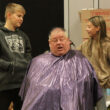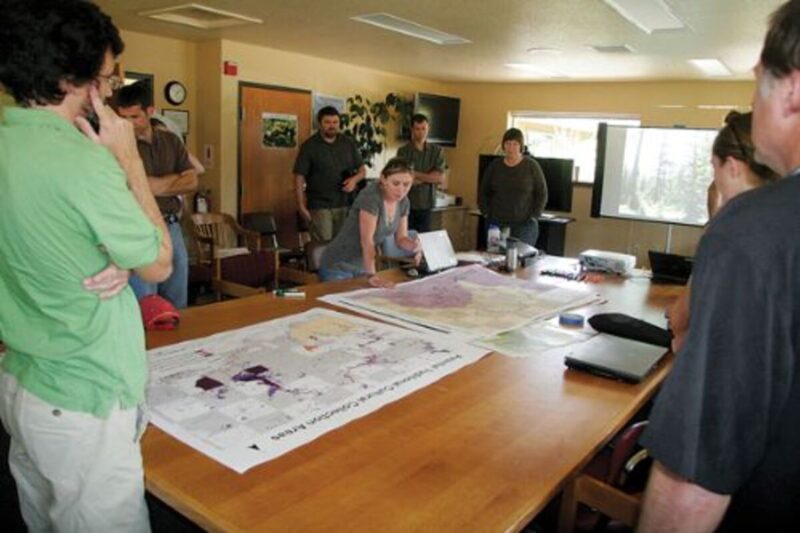Sean C. Morgan
The U.S. Forest Service Sweet Home Ranger District is putting the finishing touches on a draft plan for the Cool Soda planning area.
The area encompasses the Soda Fork drainage and Cool Camp, including Willamette National Forest land and privately owned forestland, primarily belonging to the Hill family and managed by Cascade Timber Consulting. The draft plan will be presented on Aug. 21 to a planning group that includes Forest Service officials, private interests, other agencies and members of the public.
A final proposal will be presented in September, and then the proposal enters the typical process for the Forest Service, including a public hearing and comments phase.
During a public meeting on Aug. 7, the planning group discussed potential projects for the area.
The projects fall into three themes: community and culture, streams and wildlife and forests and wildlife, said Cindy Glick, district ranger. Preliminary ideas include tribal projects, with input from the Confederated Tribes of the Grand Ronde; wildlife; commercial products; recreation and firebreaks; aquatic restoration; and roads.
Tribal interests include restoring anadromous, migrating fish habitat; the Harter Mountain area; easy access for seasonal gathering, such as bear grass, cedar bark collection and burning; and protection of cultural resources during any action in the area, said Anita Leach of the Sweet Home Ranger District.
Bill Marshall of Cascade Timber Consulting said that CTC has already secured grants to help fund $150,000 in wildlife restoration projects.
“Here we are, a timber company, and we’re going to be enhancing forage,” Marshall said. Closed canopy means minimal food, with minimal sunlight. It’s woody and old. Open canopy allows sunlight and lush growth near the ground, which provides food for wildlife.
Past harvesting practices in the Cool Soda area have led to mostly closed canopy, Marshall said. Clear cutting and harvesting in the past four years on private land have created the first few openings.
CTC has seen heavy use of those areas by deer and elk, Marshall said. They’ve been pulling seedlings from the ground, and traditional seedling protection hasn’t been working.
Partners in the potential solution include the Forest Service, Oregon Department of Fish and Wildlife, the Oregon Hunters Association and Helena Chemical, Marshall said. Project ideas include planting and seeding some of the preferred browsing species; establishing “linear meadows,” or roads with food; and enhancing meadows, slide areas and slopes to improve forage.
Planners are seeing opportunities to create travel corridors and “early seral forest,” young open forest, for wildlife throughout the area, said Tiffany Young, biologist with the Ranger District. The blueberries, huckleberries and vine maple of the Cool Soda area have been slowly encroached by conifers and rhododendrons. The last 50 years have created “vast seas of rhododendrons,” impacting early seral species. Additional wildlife projects will likely need to include pre-commercial thinning in areas where the Forest Service was attempting to create early seral habitat.
Seral (rhymes with “feral”) stages are various age classes of forests, from early – in which trees are seedlings and surrounded by grasses and other low-growing plant life, such as occurs after fire, disease or drought – to late, where trees are mature and dominate the forest.
Early seral forests are becoming less common on federal lands, which have been managed for late successional species, Leach said.
Commercial products in the area include bear grass and noble fir boughs, in addition to timber, Leach said. Much of the land is high-elevation and slow-growing. Even in managed stands planted in the 1950s, the trees are smaller, but the area has commercial potential in other products, such as the fir boughs.
Recreation Planner Jon Meier, of the Sweet Home and Detroit ranger districts, envisions a trail from Moose Creek to Crescent Mountain. It would pass through the Cool Soda Planning Area, ideally with a cabin system for hikers. He also would like a trail constructed to Soda Fork Falls, which is on CTC-managed property and would thus require support from the Hill family.
Aquatic and road restoration projects include the replacement of a number of culverts that are undersized to keep water from backing up behind roads and then blowing them out. Others include potential in-stream improvements to create more habitat and breeding areas and better passage for anadromous fish, such as Chinook salmon and steelhead.
“One of the things is it’s creating jobs,” said Ranger District Hydrologist Lance Gatchell. “We come up with some money, hire someone.”
The proposal also will identify areas that could be harvested, which could generate revenue for other projects.
The draft proposal will be unveiled at the next meeting, 1 p.m. to 4 p.m. on Aug. 21 at the Sweet Home Ranger District Office.





